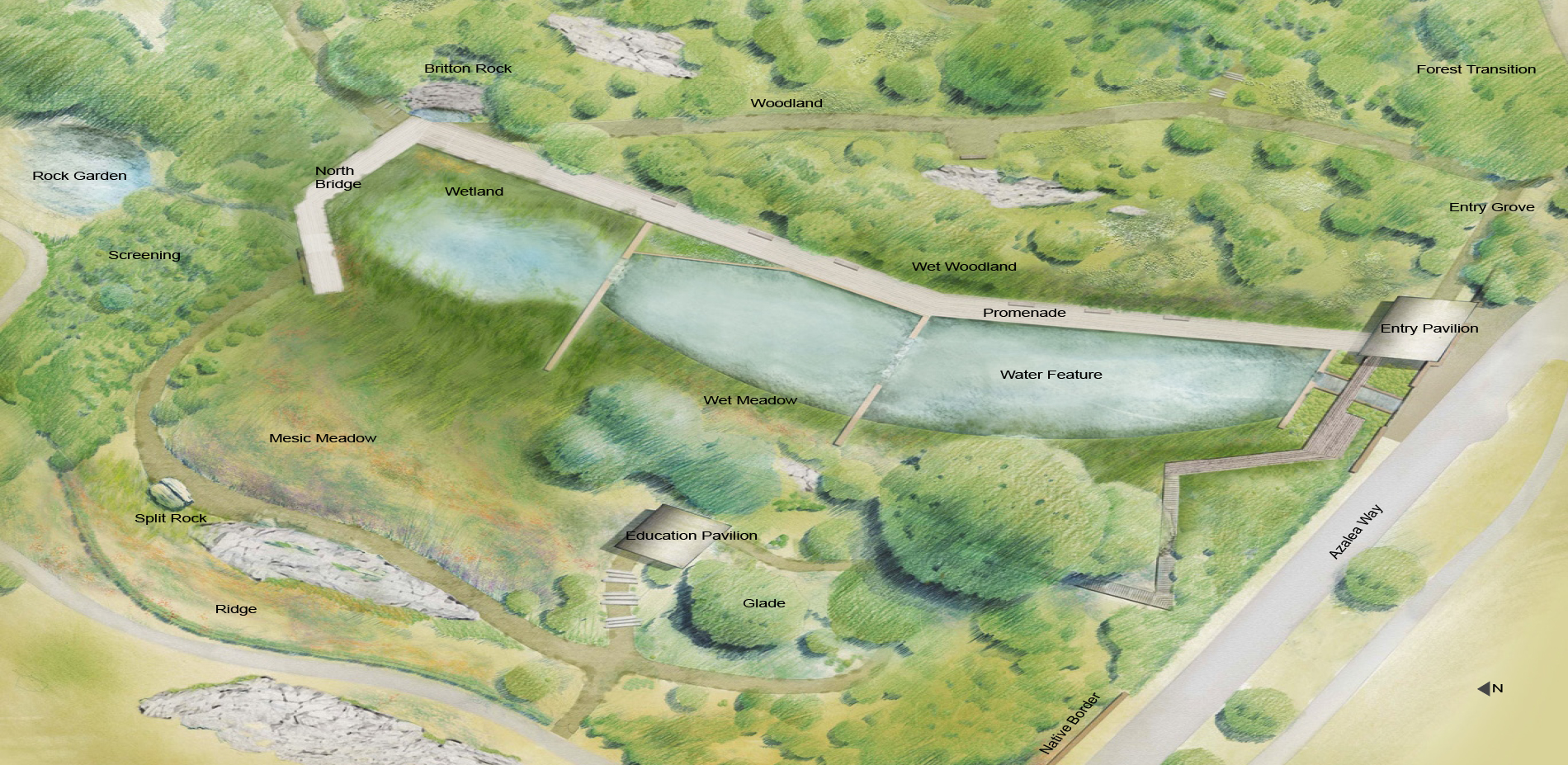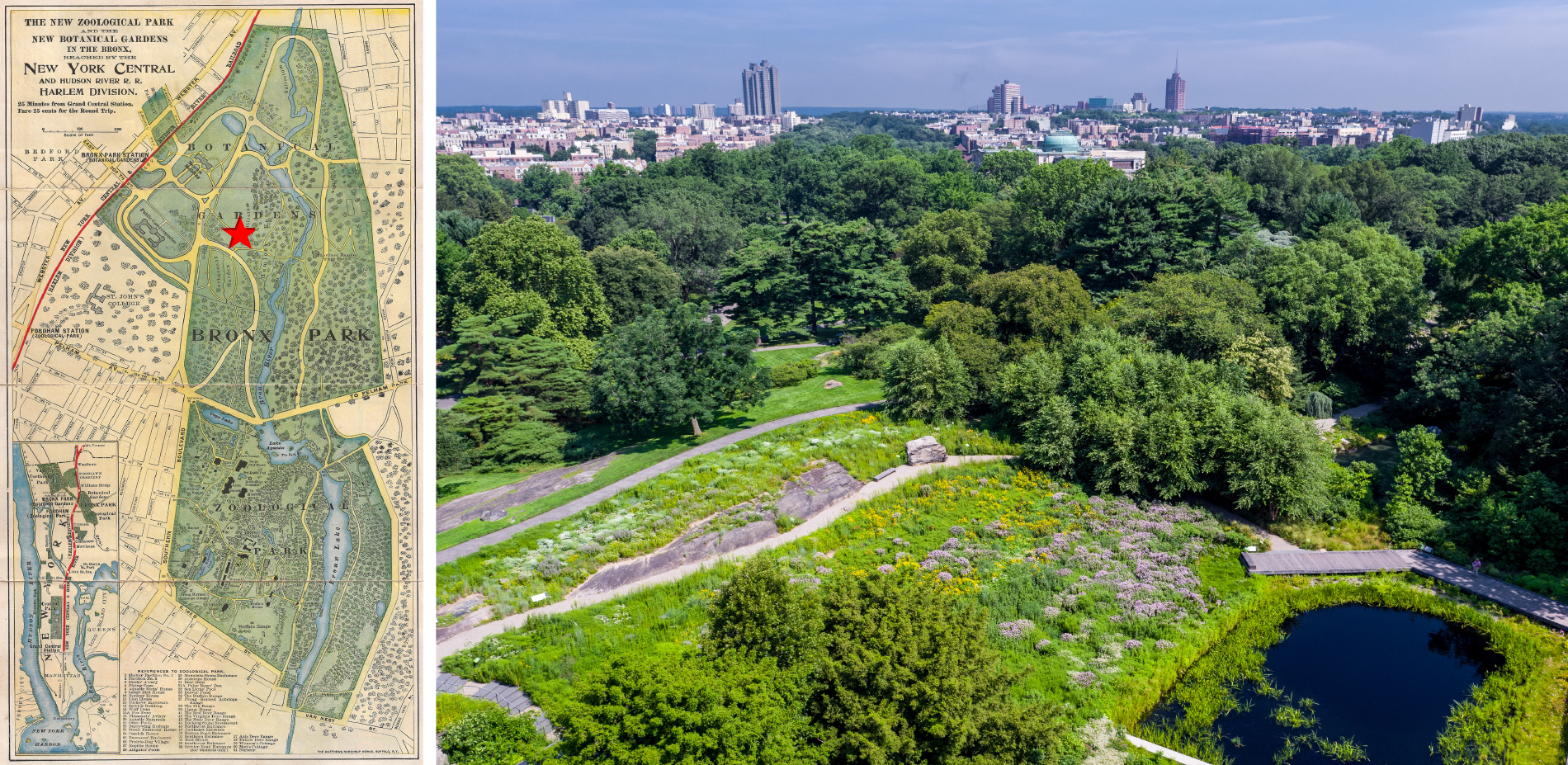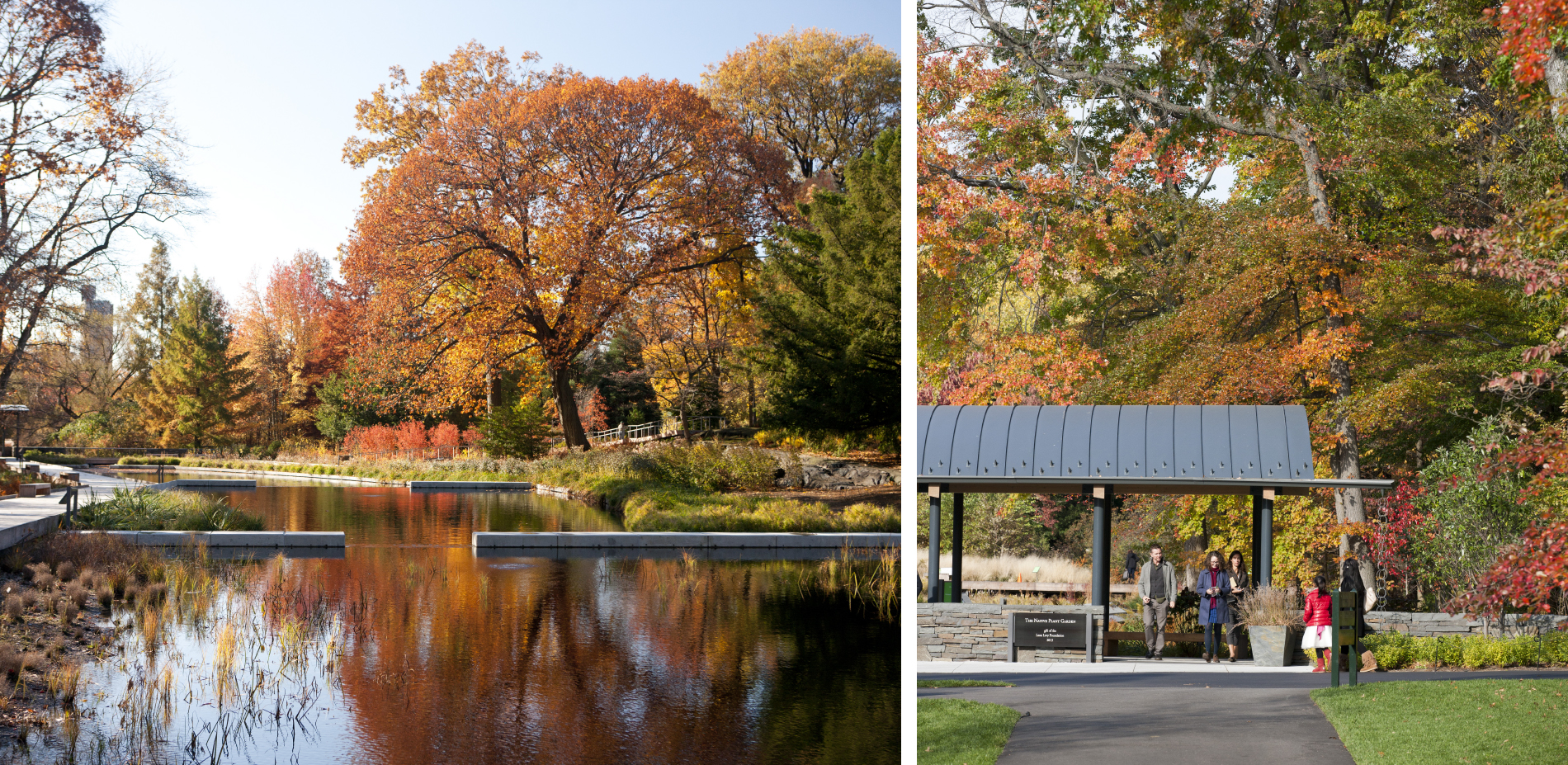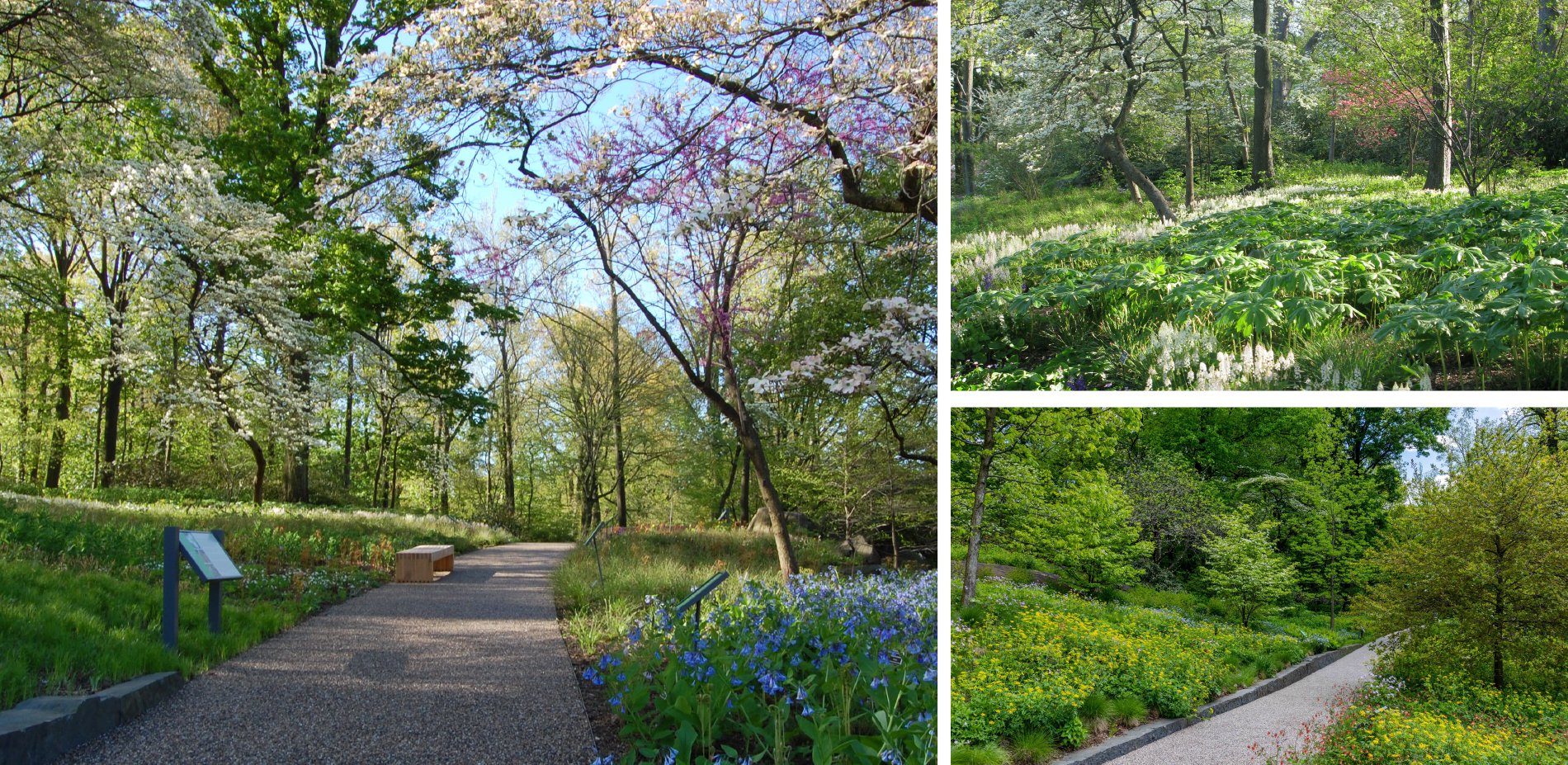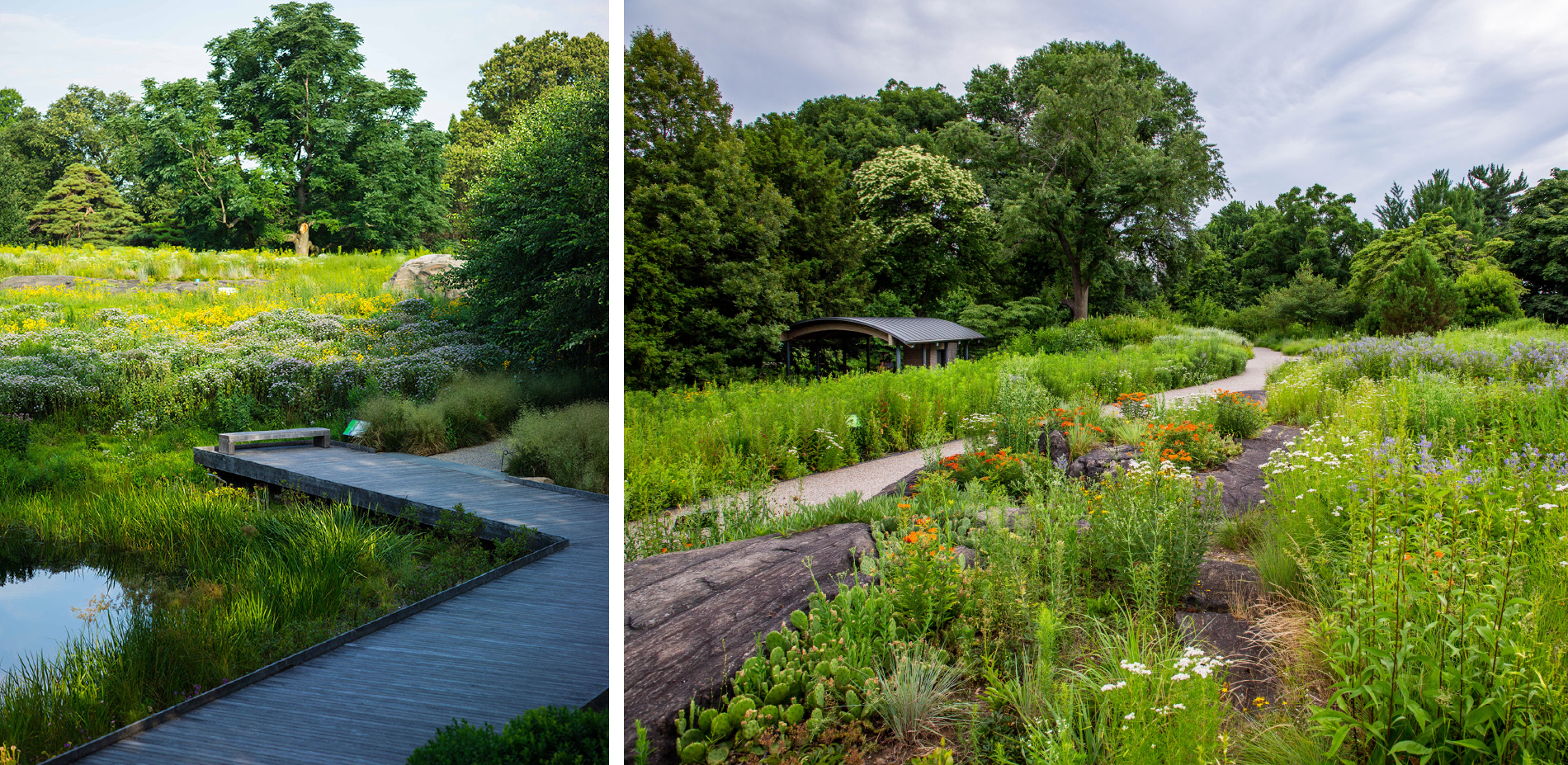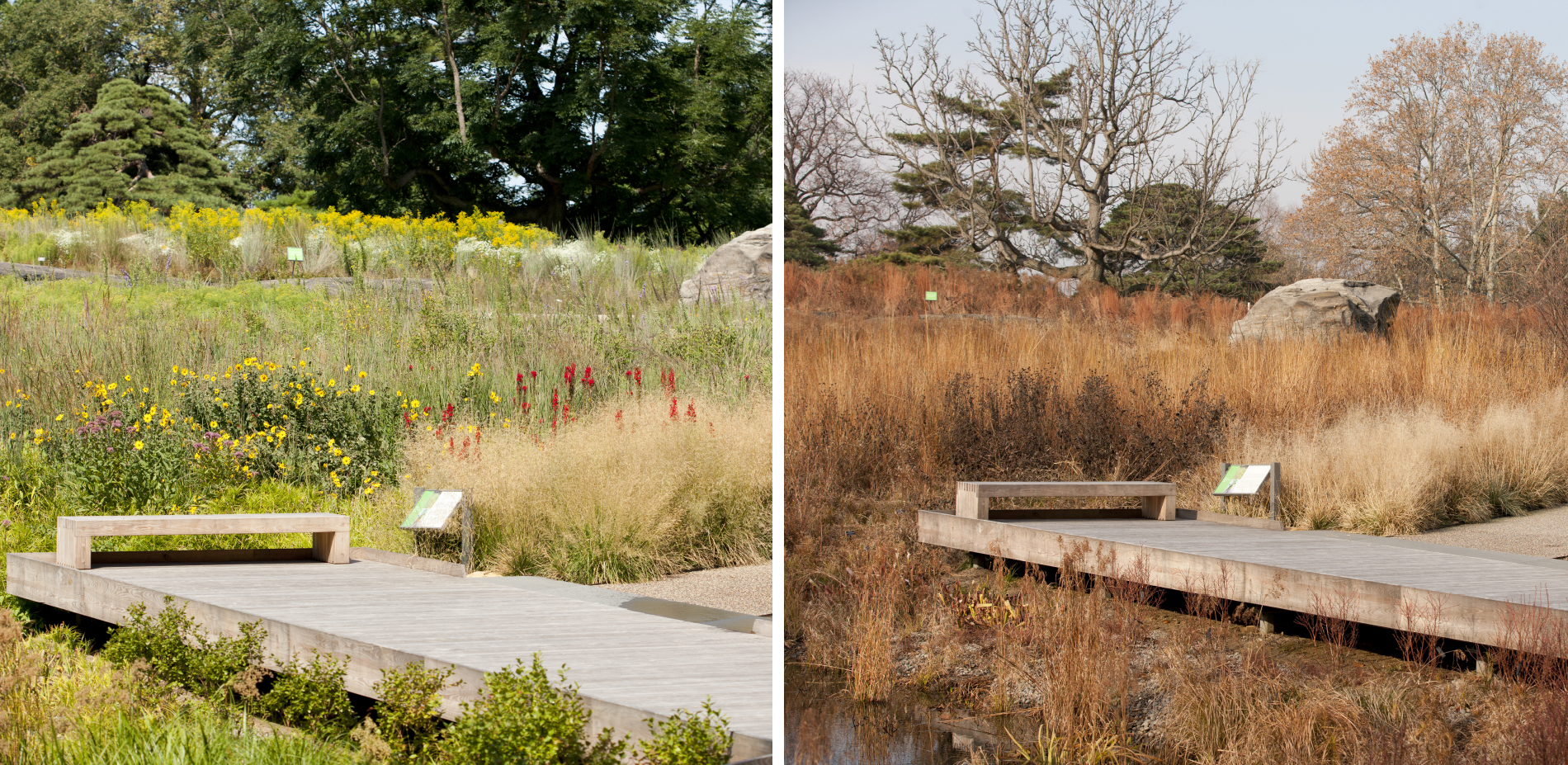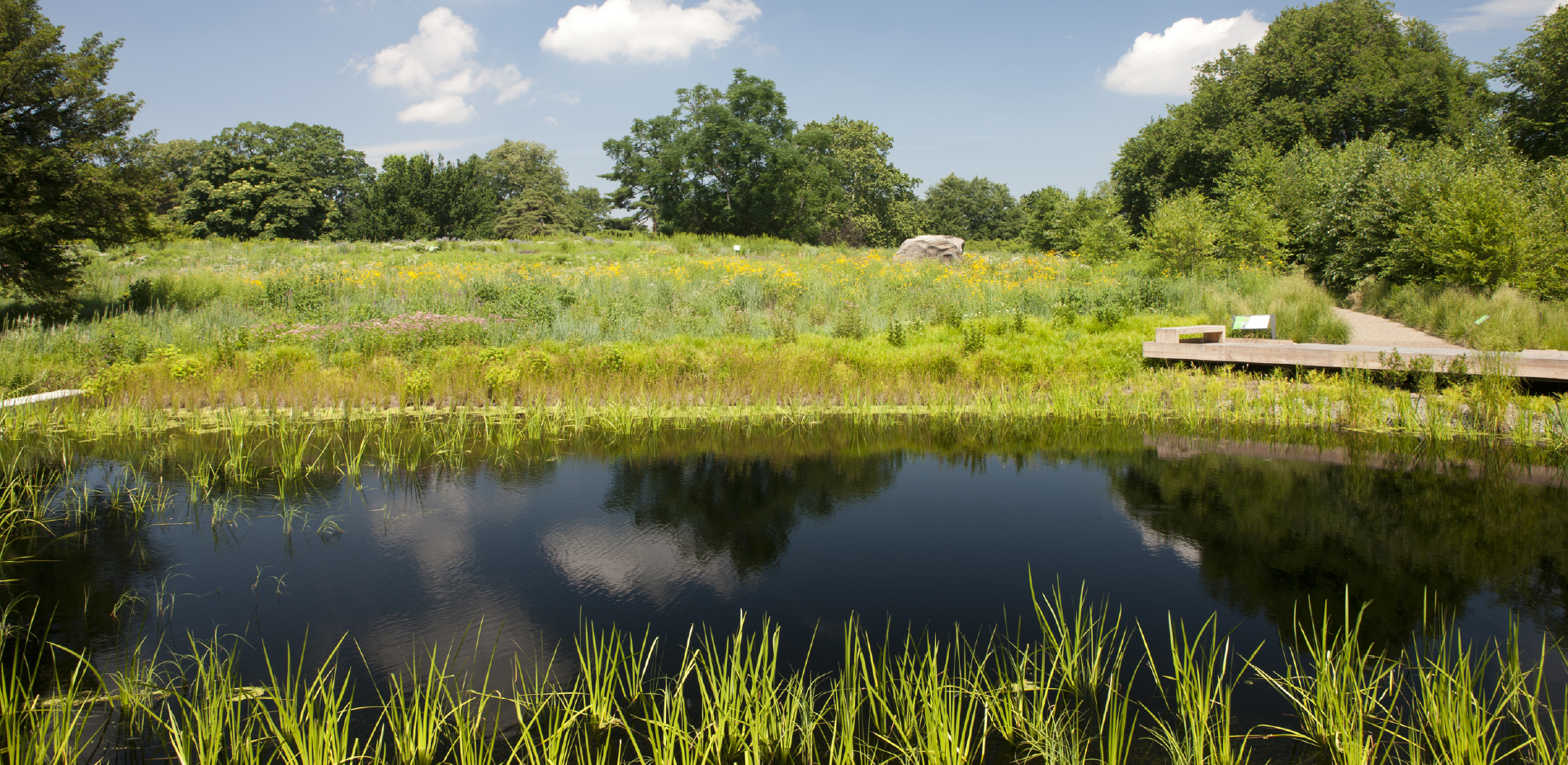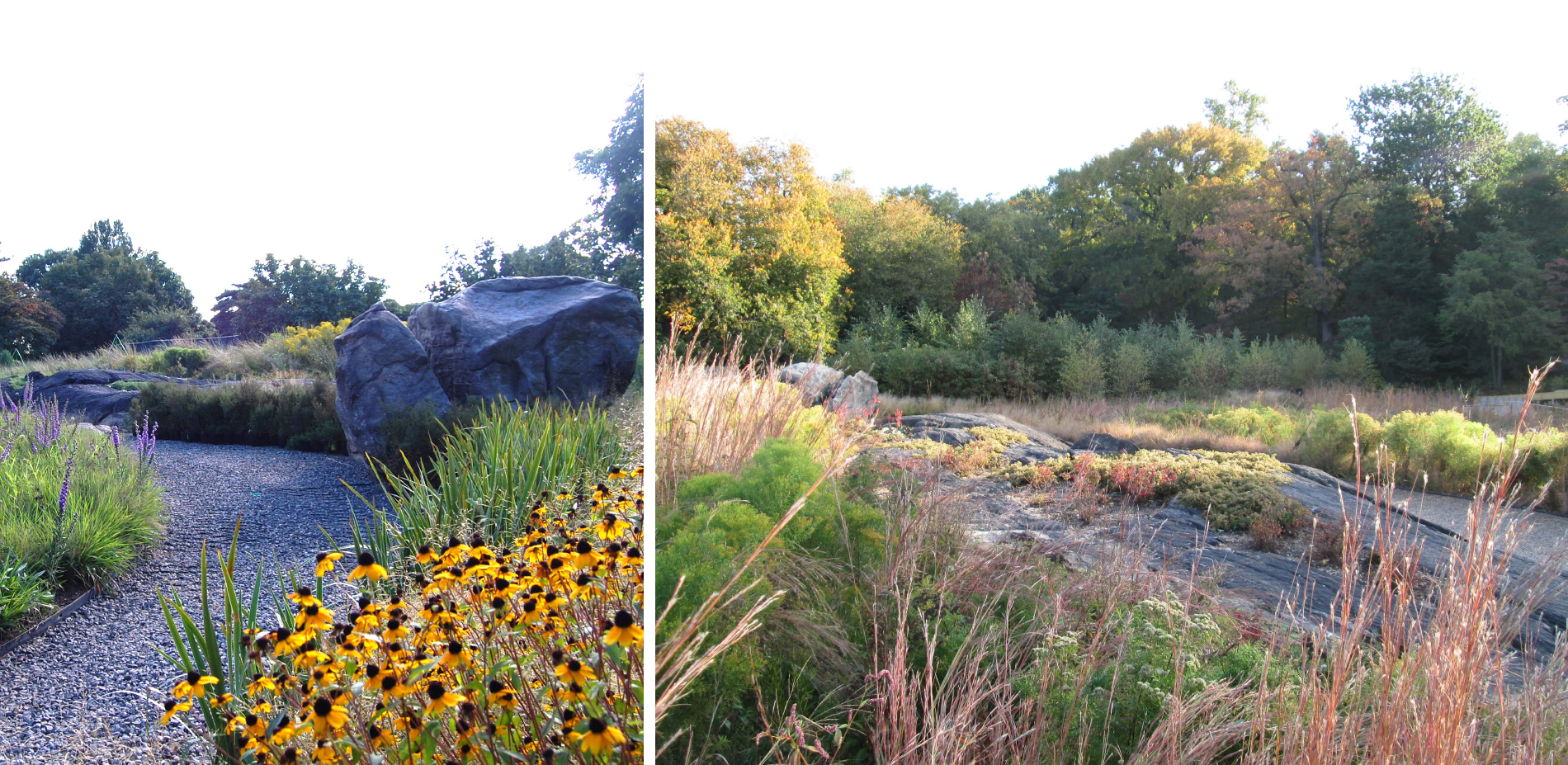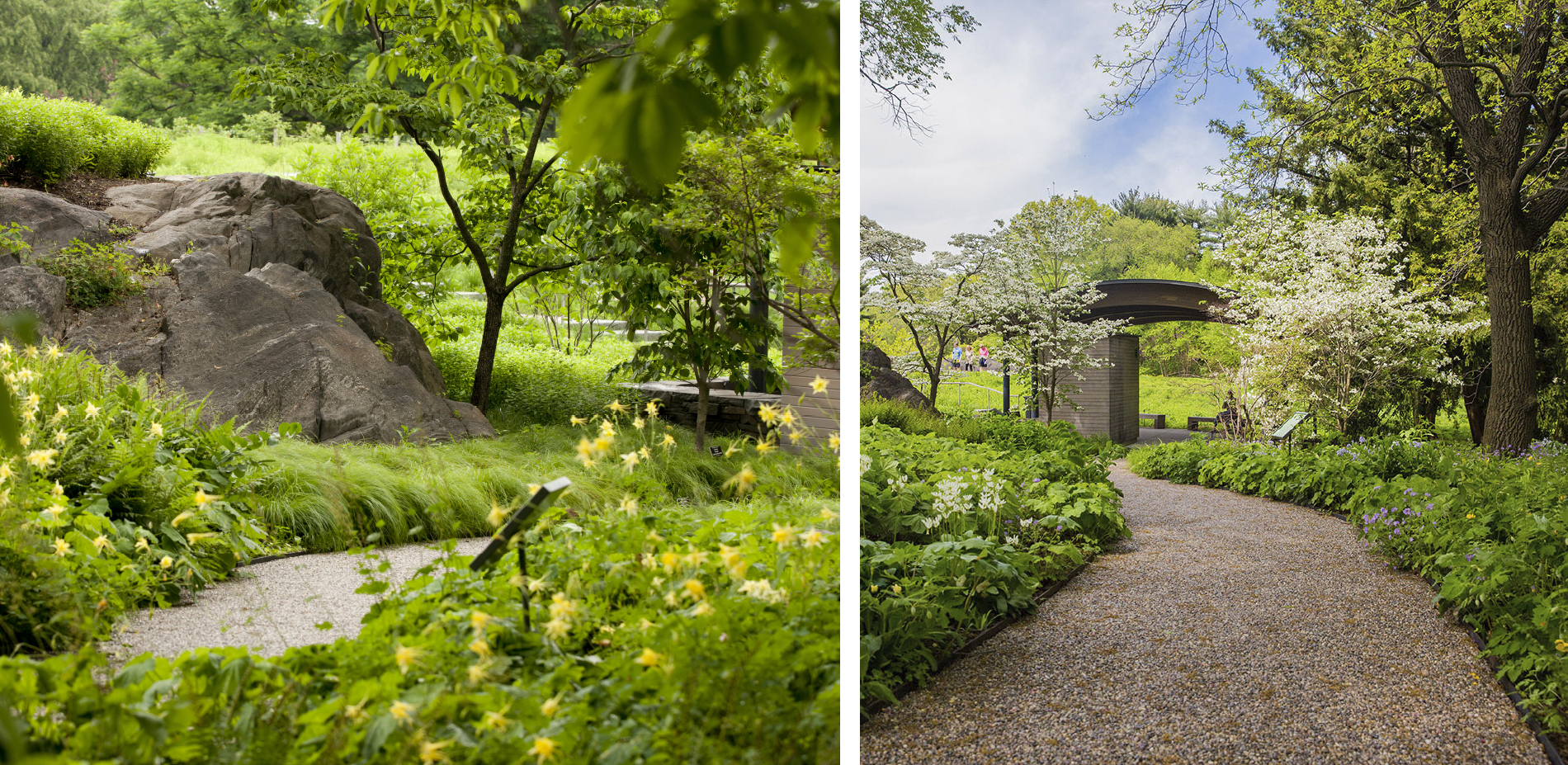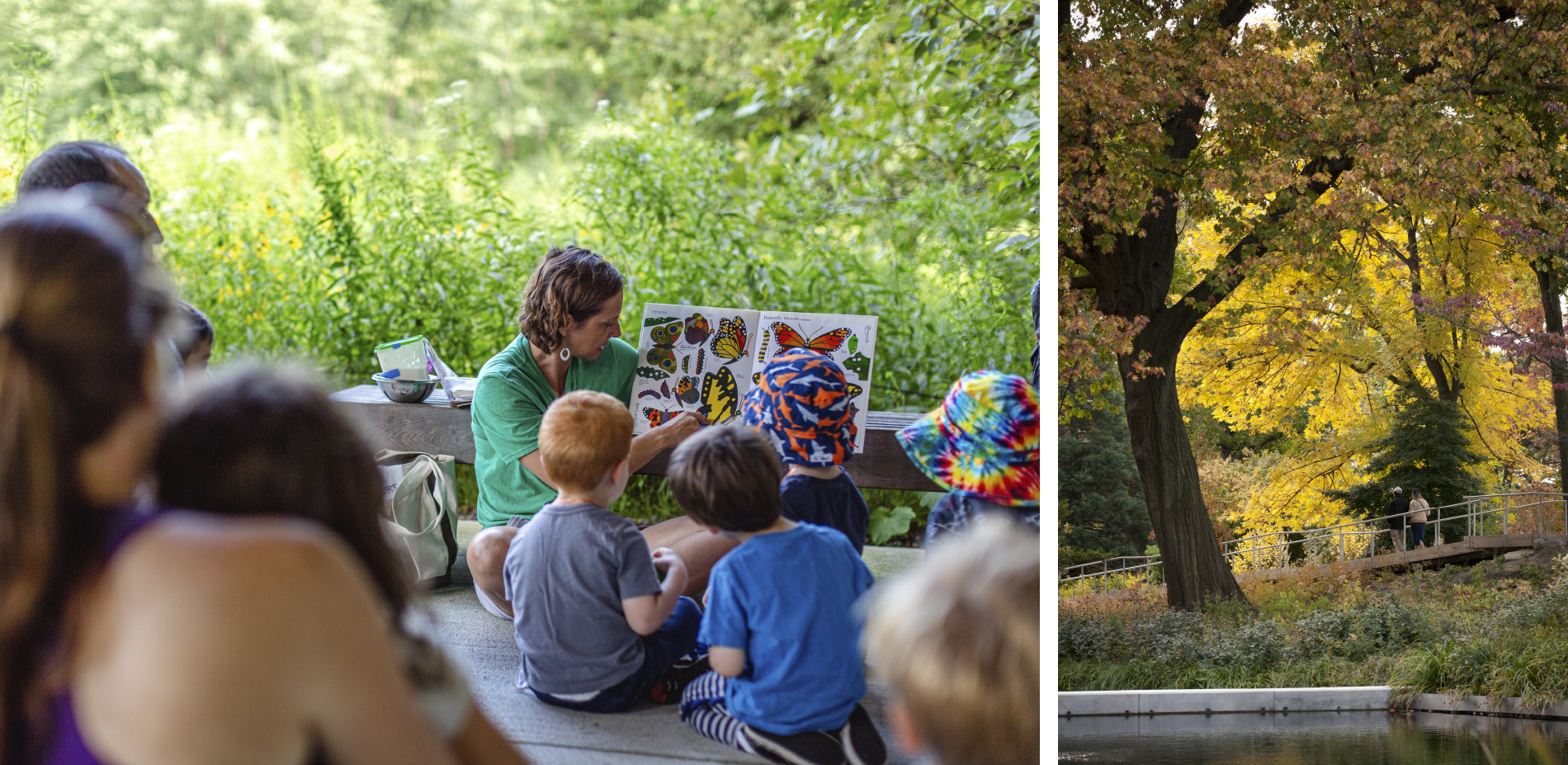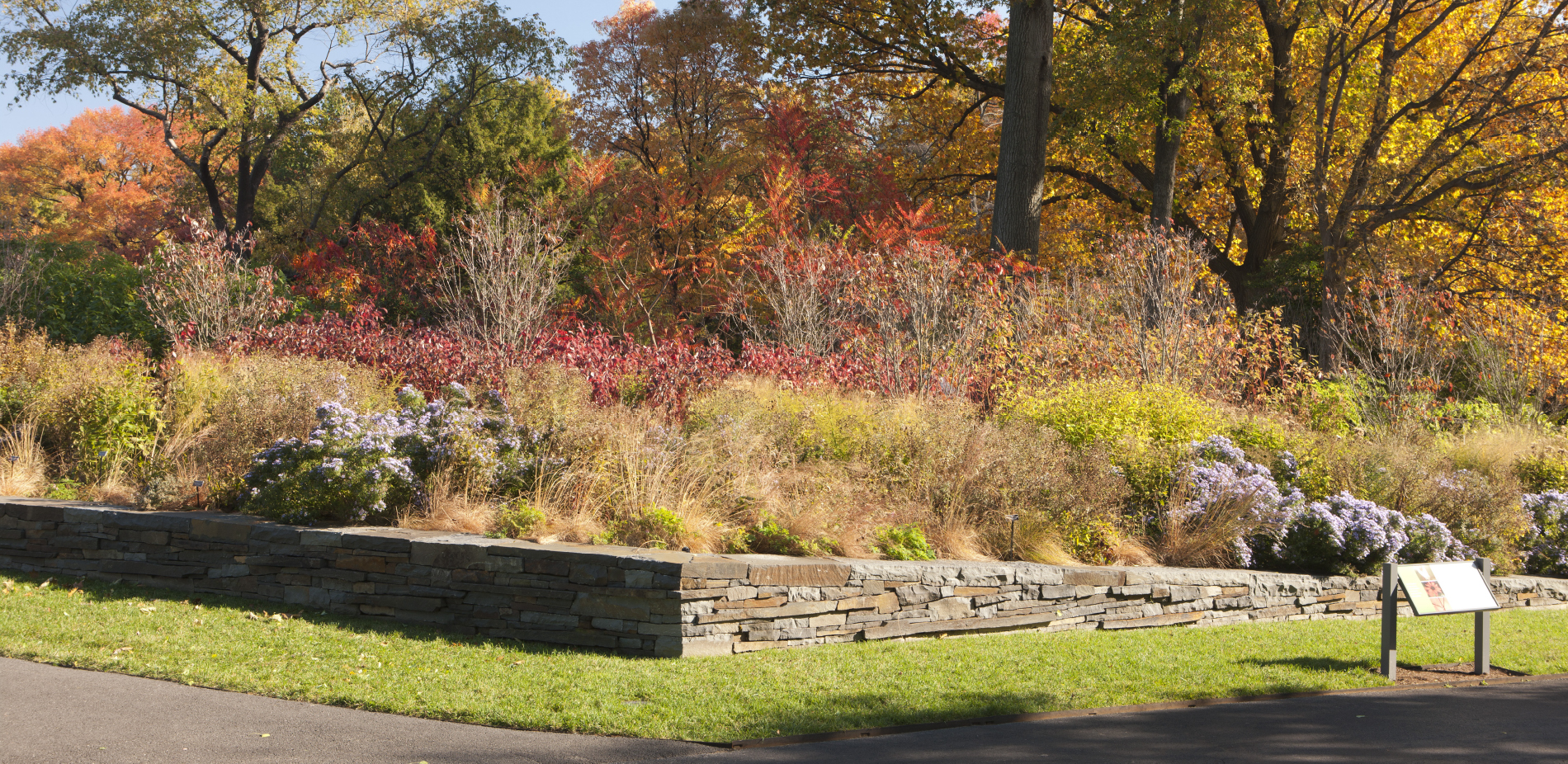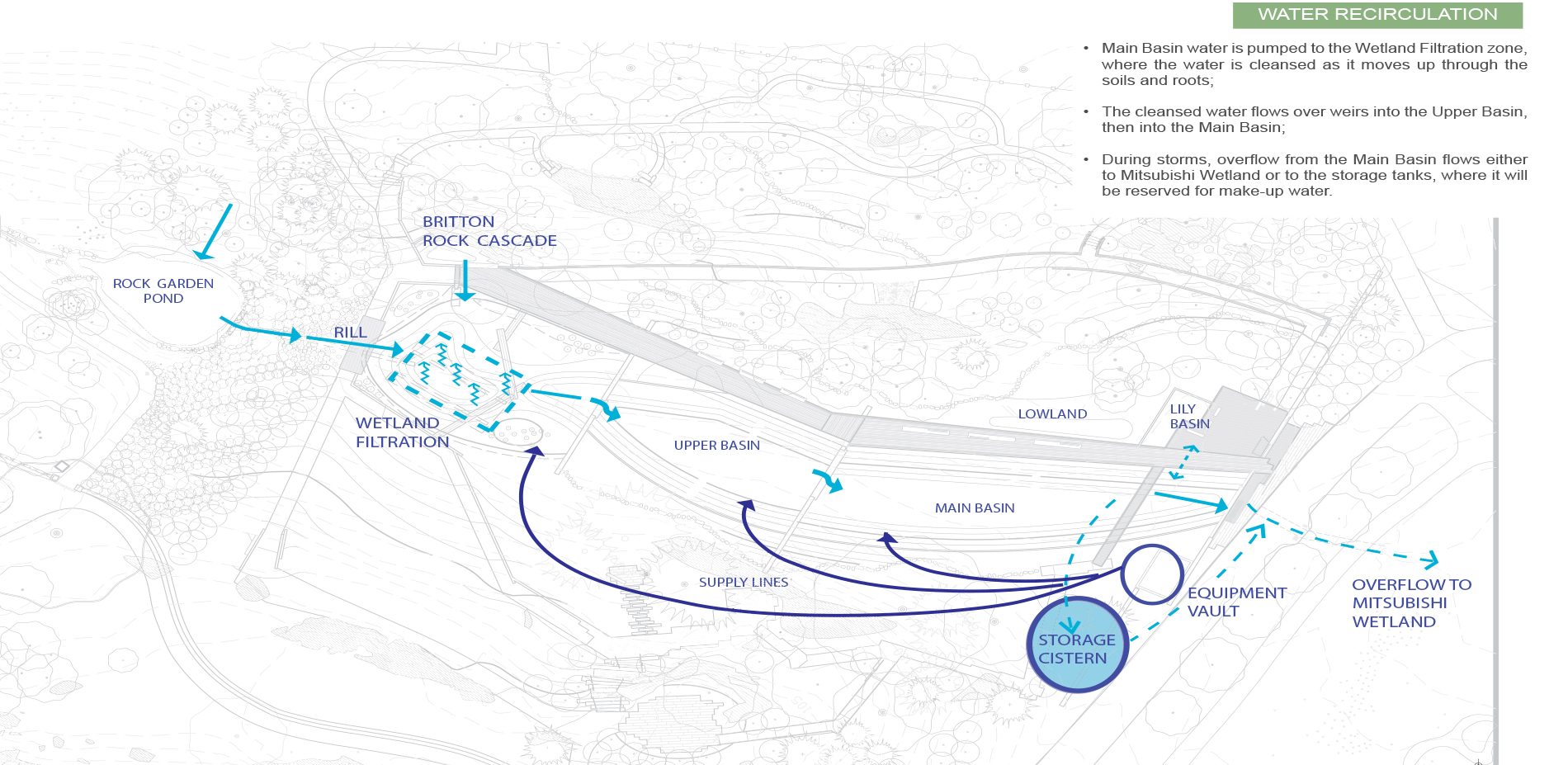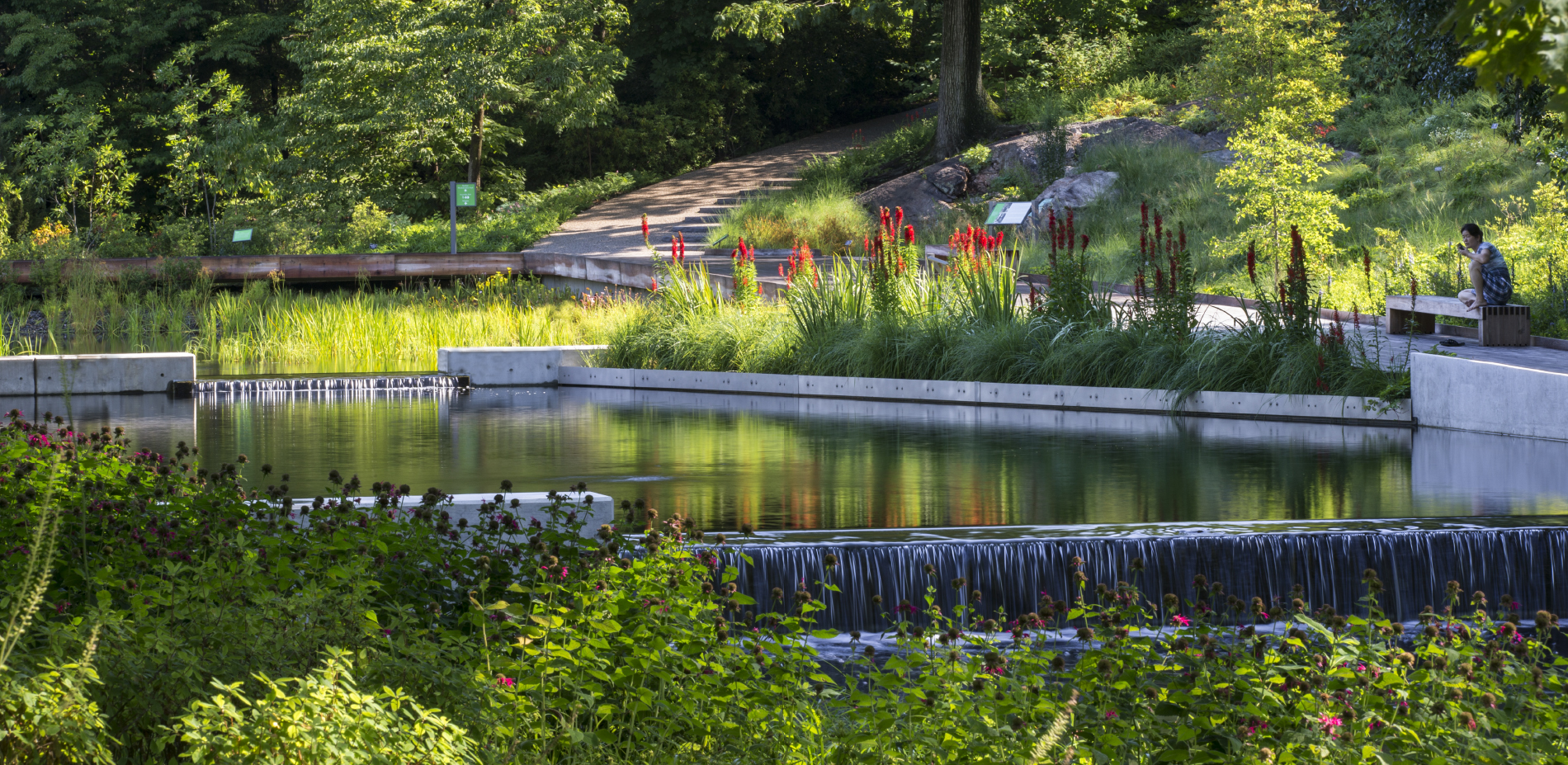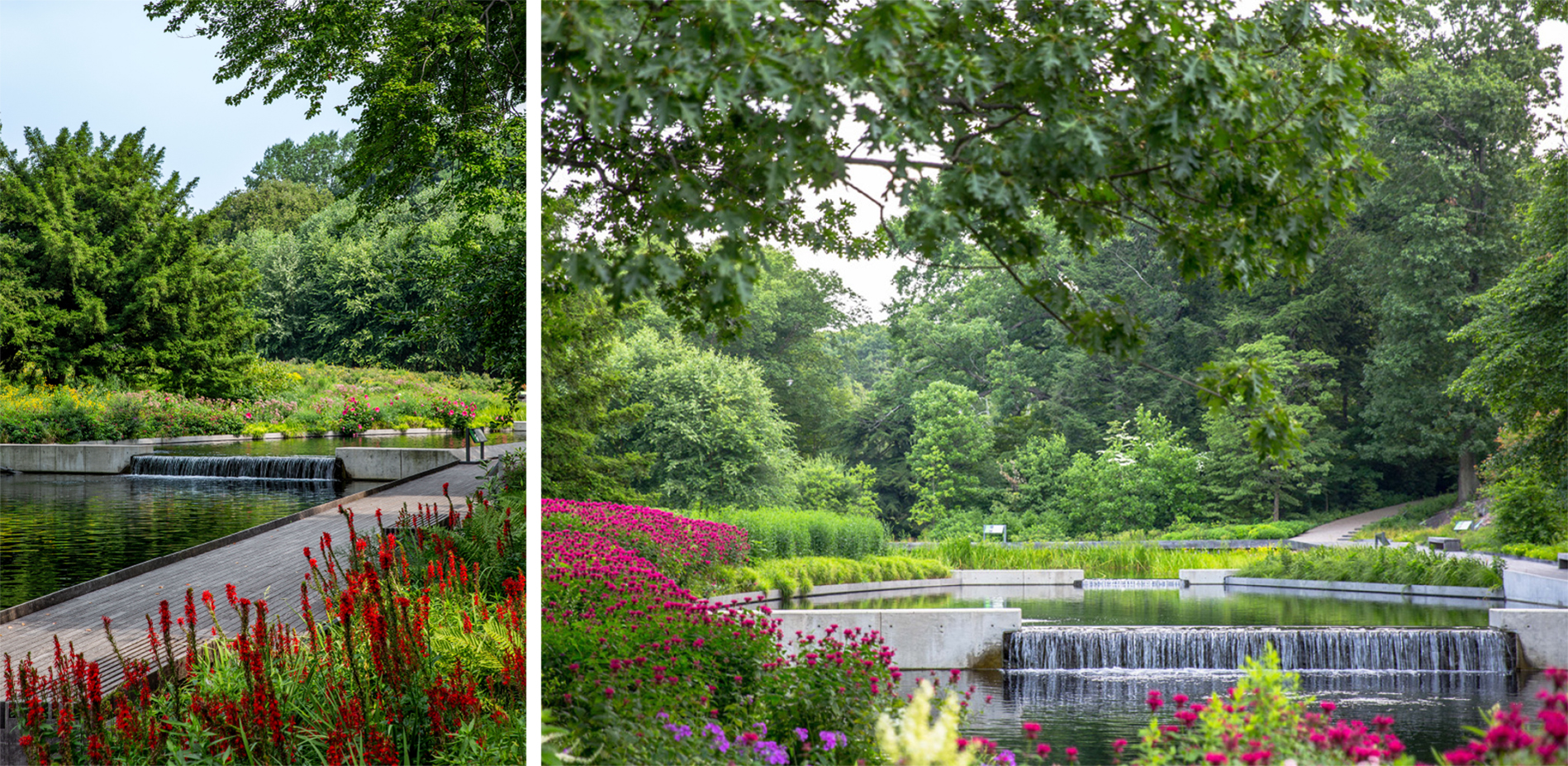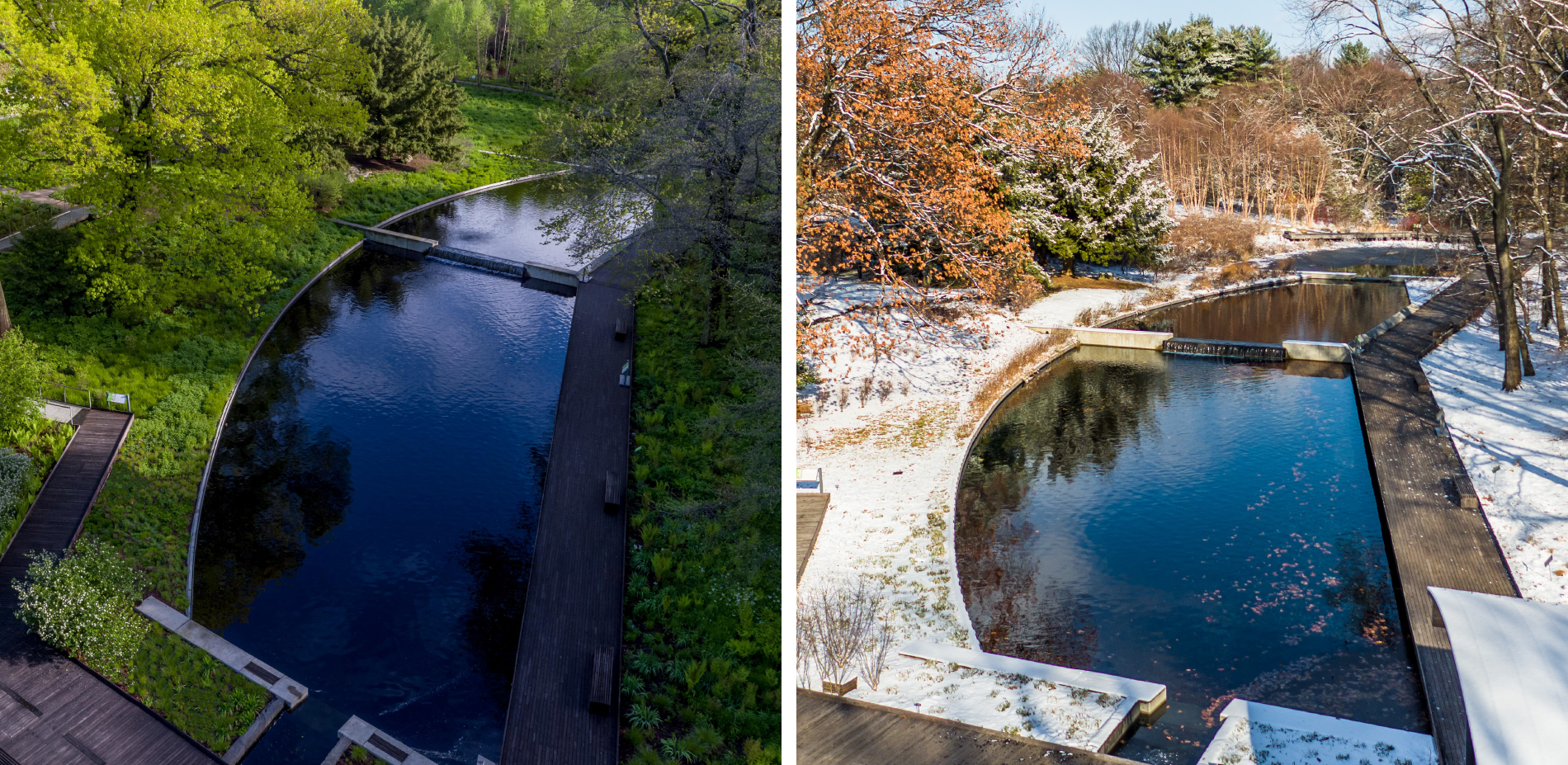The Native Plant Garden at The New York Botanical Garden
Honor Award
General Design
Bronx, New York, United States
OEHME, VAN SWEDEN | OvS
Client: The New York Botanical Garden
Central to the New York Botanical Garden is its 3.5-acre Native Plant Garden, which boasts nearly 100,000 plants across four ecosystems (glade, meadow, wetland, and woodland). The Bronx River flows through the site, and, with this revitalization effort, stepped basins along an articulated curve provide natural filtration and rainwater surge retention through aquatic species on its way to the East River. Where unchecked growth had rendered the garden’s plant diversity illegible, the designers chose embedded rock formations as focal points within more selectively curated outdoor rooms; an accessible primary pathway winds between these, offering both closer looks at rare species and broader vistas across the refreshed garden.
- 2020 Awards Jury
Project Credits
H3 Hardy Collaboration, Architect (Pavilions)
CMS Collaborative, Water Feature Designer
Robert Silman Associates, Structural Engineer
Langan Engineering, Civil Engineer
Darrell Morrison , Native Plant Consultant
Nitsch Engineering, Hydrological Engineer
Accu-Cost Construction Consultants, Inc., Cost Estimating
Pine and Swallow, Soil Consutltant
Langan Engineering, Geotechnical Engineer
James R. Gainfort, AIA Consulting Architects PC, Waterproofing Consultant
Heller & Metzger, Specifications Writing
NYBG Staff, Planting Design Consultation
Bruce O'Brien, O'Brien Stoneworks, Inc, Dry Stacked Stone Walls / Masonry
E.W. Howell, Project Management
Project Statement
Showcasing the beauty and biodiversity of the Northeastern United States, the native plant garden at the New York Botanical Garden is a model for how landscape architects can weave native ecologies into garden settings. Bursting with nearly 100,000 native plants representing 450 taxa, the new garden highlights the aesthetic and ecological value of native plants, capturing runoff, providing habitat, and inviting visitors to explore nature through experience and observation. Distilled from native ecosystems found throughout the Northeast, garden themes derive from the site’s natural topography and hydrology, informed by a careful analysis of existing habitats and microclimates. A fully accessible path hinges around a series of garden rooms and rock outcroppings, connecting visitors to the site’s unique geomorphological history, while a sculptural water feature doubles as an industrious landscape machine, demonstrating the potential of biofiltration and on-site stormwater management. The interdependence of native plant communities is made visible through the garden’s thoughtfully composed landscape typologies, which together form an important and ecologically responsive urban refuge for imperiled native bee, bird, and butterfly species.
Project Narrative
REIMAGINING A NATIVE GARDEN
The Native Plant Garden at the New York Botanical Garden—a National Historic Landmark established in 1891—is one of the oldest displays of native plants in the country. Developed by the horticulturist T. H. Everett in the 1930s, the 3.5-acre garden occupies a bowl-shaped site near the center of the botanical garden’s 250 acres. Its sloping ridges are characterized on one side by an old-growth oak-hickory woodland and throughout by prominent outcroppings of Hartland schist, the bedrock of the New York City region.
Over the years, the native plant garden had grown illegible. Dense plantings alongside a manmade stream obscured views across the site, and attempts to replicate less common ecosystems, such as New Jersey’s pine barrens, had failed due to the garden’s limited size. The landscape architects were brought on to reimagine the historic landscape as a vibrant, contemporary native garden, with an emphasis on linking the botanical diversity of the Northeast with sound horticultural principles.
The goals of the redesign included educating visitors about the aesthetic and ecological value of native plants, creating a year-round spectacle through a celebration of diverse native plant communities, enhancing circulation and the visitor experience, and improving the health of the Bronx River by demonstrating sustainable stormwater management strategies.
SITE ANALYSIS
Extensive surveys of the site’s soils, vegetation, topography, and drainage guided the team’s approach. Particularly important was a thorough analysis of the garden’s existing tree canopy and its most prominent geological features, which in addition to schist outcroppings, included an iconic glacial erratic known as Split Rock, whose dramatic fissure was created by glacial movement. These natural features became pivotal to both planting and circulation, serving as visual nodes that connect visitors to the site’s geomorphological history and creating microclimates that support unique plant communities.
A hierarchy of path systems, including a primary ADA-accessible route, provide visitors with a range of sensory experiences, from sweeping views to intimate interactions with rare plant species. Throughout, paths and hardscape elements were carefully sited and constructed to avoid the root zones of existing mature oak, hickory, and tulip poplar trees, while materials were sourced from within 100 miles of the site to reduce their carbon footprint. The garden’s prized collection of Trillium grandiflorum, a charismatic spring ephemeral that is listed as “exploitably vulnerable” in New York State, was carefully transplanted during construction, then replanted.
REFINING NATURE FOR THE GARDEN
Through its varied topography and hydrology, the site naturally divided itself into a series of landscape types, from xeric ridge to wet swale. Each typology offered distinct vegetative, artistic, and experiential themes and together served as the basis for a series of garden rooms inspired by ecosystems common to the Northeast: Woodland, Meadow, Wetland, and Glade. Within each habitat, microclimates created additional opportunities to showcase native plant communities, while the introduction of a large water feature enabled the creation of more hydric habitats, such as a wet meadow, wet woodland, and emergent wetland.
To create a coherent garden experience, the team distilled each archetypal ecosystem into its visual essence, emphasizing color, contrast, texture, and seasonality. The goal was to capture the spirit of native plant communities without replicating them. In Meadow areas, a complex tapestry of colors and textures emerge seasonally out of a base matrix while a pointillist second layer of herbaceous flowering material creates color and visual interest. The interplay of heath and grasses forms a bold mosaic that accents the rock outcrops. Glade and Woodland sections are treated as outdoor cathedrals, with canopies forming arched ceilings over a richly patterned ground plane of ferns and spring ephemerals, while at the entrance, a dazzling array of native wildflowers beckons visitors to explore the garden beyond.
Through close collaboration with the garden’s horticulture staff, the landscape architects selected more than 450 unique taxa from an initial list of more than 3,000. Nearly 100,000 new native trees, shrubs, ferns, grasses, sedges, spring ephemerals, and wildflowers generate an immersive experience that showcases the rich biodiversity of the Northeast. Maintained in the garden are seven plant species, including Helonias bullata, that are propagated as part of the National Collection of Endangered Plants, the largest living collection of rare plants in the world.
AN URBAN REFUGE
Special consideration was given to transition zones (ecotones) between habitats. Plants were carefully selected to create transitions that are experientially and functionally seamless. Equal attention was paid to structure and composition aboveground and below, ensuring the long-term health and biodiversity of the various plant communities.
By maximizing biodiversity, the garden supports stable, balanced, and diverse food webs. Located in the heart of the Bronx, these native ecosystems serve as a vital refuge for native wildlife. Asclepias viridis, Lobelia cardinalis, Eutrochium dubium, and numerous other plant species attract pollinators such as bees, hummingbirds, and monarch and swallowtail butterflies, while the garden’s wide range of habitats have become home to an abundance of birds, insects, amphibians, and reptiles—indicators of a healthy and functioning ecosystem.
A HARD-WORKING WATER FEATURE
An early objective of the project was to improve the health of the Bronx River by demonstrating on-site, landscape-based stormwater management. The Bronx River, the only freshwater river in New York City, flows south from the Kensico Reservoir, through the botanical garden, and into the East River. Its water quality has been degraded by nutrient-rich runoff and combined sewer overflows. To reduce pollutant loads, the team developed an innovative central water feature that uses natural hydrologic systems to replenish and nurture the overall bio-system.
The 230-foot-long, crescent-shaped water feature comprises a series of stepped basins that replace the existing stream and eliminate nearly all potable water use in the garden. Following the site’s natural topography, the water cascades over massive slabs of local Hamilton bluestone, creating sound and motion that provide a feeling of tranquility. Inspired by the sculpture of Martin Puryear, the water feature is crisply defined, edged in steel and flanked by an angled promenade made out of kiln-dried American black locust.
What appears as a tranquil pond is, below the surface, a complex hydrologic machine. Employing sophisticated biofiltration strategies designed in collaboration with a team of water feature consultants, the system stores and recycles 300,000 gallons of rainwater. From the wetland, where aquatic species and beneficial bacteria provide natural filtration, the water flows into an upper basin and then into the main basin, where it is treated using a bag filter and UV sanitation and stored in a series of three underground cisterns with a capacity of 50,000 gallons.
Excess water is pumped back to the wetland filtration zone via a sand and gravel filtration system. In the event of heavy rain, the water overflows to the adjacent Mitsubishi Wetland Trail, where it undergoes additional biofiltration before entering the Bronx River.
OUTCOME
Opened in 2013, the new native garden is the culmination of five years of intense collaboration. Treated as an immersive and inviting work of landscape art, it redefines the native plant garden for the 21st century, supporting ambitious public programming and serving as an integral part of the NYBG’s world-renowned botanical research program. It offers the garden’s more than 1.3 million annual visitors a multitude of experiences: Local schoolchildren regularly gather beneath the native garden’s covered pavilions to learn about the importance of water and native ecosystems, and the awakening of the woodland in the spring has become an annual attraction, when wide swaths of ephemeral wildflowers burst into bloom, painting the landscape in vibrant hues of blues, violet, and whites. More than a tribute to the natural beauty of the Northeast, the garden is a testament to the power of landscape to make ecological processes vital and visible.
Products
- Water feature plumbing and site irrigation - R&R Irrigation Co, Inc
- Boardwalks - Ken Hettinger Construction Co, Inc
- Pavilion - Wood Construction Systems, Inc
- Pavilion Roofing - Telentos Construction Corp
- Wetland filtration system - Aquascapes
- Pond liner - EPDM
- Gravel-Lok
- Stone Supplier - New York Quarries
- Precast vault - Oldcastle Precast-New England
- Precast concrete - David Kucera Inc
Plant List:
- Mertensia virginica
- Trillium grandiflorum
- Delphinium tricorne
- Helonias bullata
- Asclepias tuberosa
- Schizachyrium scoparium
- Euthamia tenuifolia
- Pycnanthemum tenuifolium
- Carex plantaginea
- Heuchera villosa ‘Autumn Bride’
- Aquilegia chrysantha
- Sporobolus heterolepis
- Symphyotrichum latiflorum
- Deschampsia cespitosa 'Tardiflora'
- Eupatorium purpureum
- Lobelia cardinalis
- Monarda didyma “Raspberry Wine”
- Geranium maculatum f. albiflorum
- Iris cristata
- Eutrochium dubium
